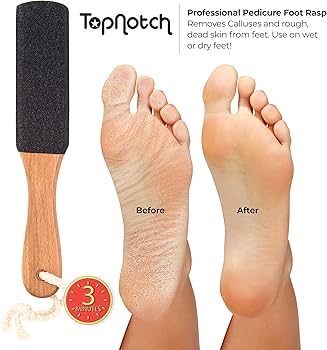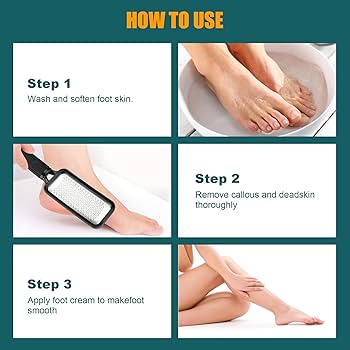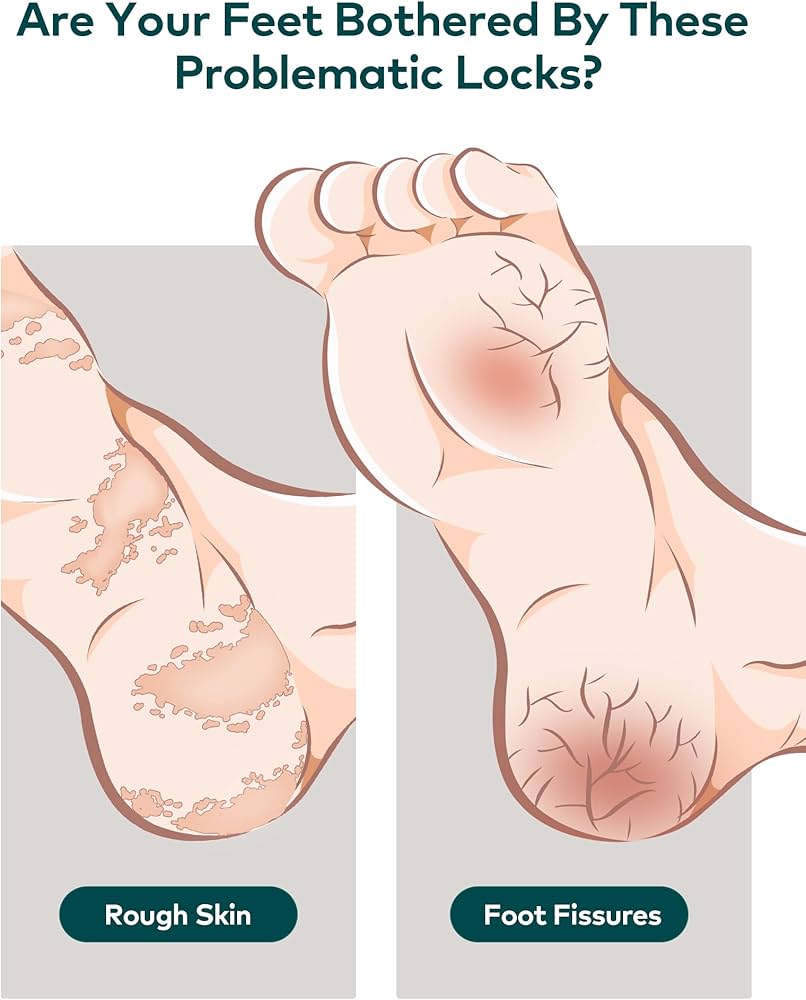Foot File Common Mistakes: Avoid These Mistakes for Smoother Feet (2025)
Discover foot file common mistakes to avoid when using foot files and rasps for DIY pedicures. Learn proper techniques for smooth, professional results every time!
Have you ever wondered why your DIY pedicure doesn’t quite measure up to professional results? The secret might lie in how you’re using your foot file or rasp. As someone who’s spent years perfecting my at-home foot care routine, I’ve learned that avoid these foot file common mistakes, can be game-changers—when used correctly.
Many of us make simple mistakes that can turn our foot-smoothing efforts into a frustrating experience. From applying too much pressure to neglecting proper cleaning, these errors not only hinder results but can also pose health risks. In this text, I’ll share my insights on the most common pitfalls to avoid when using foot files and rasps, helping you achieve salon-worthy feet from the comfort of your home.
Understanding Foot Files and Rasps
Foot files and rasps are essential tools for maintaining smooth, callus-free feet. I’ve found that these instruments come in various shapes and materials, each designed for exact foot care needs.
Foot files typically feature a flat or curved surface with an abrasive texture. They’re ideal for gently removing dead skin and smoothing rough patches. I’ve used both metal and glass foot files, but I prefer glass ones for their durability and ease of cleaning.
Rasps, on the other hand, are more aggressive tools. They often have a coarse surface with raised ridges or holes, designed to tackle thicker calluses and stubborn dead skin. I’m cautious when using rasps, as their effectiveness can also make them potentially harmful if misused.
When selecting a foot file or rasp, I consider:
- Material: Stainless steel, glass, or ceramic
- Grit level: Fine for sensitive skin, coarse for tougher calluses
- Handle design: Ergonomic grip for comfortable use
- Size: Compact for travel or larger for home use
I’ve learned that understanding the differences between these tools is crucial for effective and safe foot care. Foot files are best for regular maintenance, while rasps are better suited for occasional use on thicker skin areas.
It’s important to note that metal “cheese grater” type rasps are often too harsh for home use. I avoid these as they can easily cause injury or spread infection. Many professional salons have banned these tools due to safety concerns.
By choosing the right tool and using it correctly, I’ve been able to achieve salon-quality results at home. But, it’s essential to remember that these tools are powerful and should be used with care to avoid damaging healthy skin.
Choosing the Right Tool
Selecting the appropriate foot file or rasp is crucial for effective and safe foot care. I’ll guide you through the different types of tools available and help you match them to your exact needs.
Types of Foot Files and Rasps
Foot care tools come in various forms, each designed for exact purposes:
- Foot File Graters: While inexpensive and effective, these carry risks. They can damage healthy skin and create open sores if used improperly.
- Pumice Stones: A safer, gentler option for removing dead skin. They’re natural and less likely to cause injury.
- Electric Callus Removers: These offer convenience and precision for regular foot maintenance.
- Emery Boards: Ideal for smoothing rough edges and fine-tuning after using more aggressive tools.
- Glass Foot Files: Durable and easy to clean, these provide a smooth finish without being too harsh.

Matching Tools to Your Needs
Choosing the right tool depends on your skin condition and foot care goals:
- For mild calluses: Start with a gentle pumice stone or fine-grit foot file.
- For thick calluses: Use a medium-grit foot file or an electric callus remover.
- For extremely rough skin: Consider a coarse-grit foot file, but use cautiously to avoid over-exfoliation.
- For sensitive skin: Opt for a glass foot file or gentle pumice stone.
- For regular maintenance: An electric callus remover or multi-grit foot file offers versatility.
Remember, avoid metal rasps or cheese graters, as they’re too harsh and can cause injury. Always prioritize safety and gentle exfoliation over aggressive removal.
Foot File Common Mistakes to Avoid
When using foot files and rasps, it’s crucial to avoid common errors that can lead to ineffective results or even skin damage. Here are some key mistakes to steer clear of during your DIY pedicure routine:
Using on Wet Skin
Using foot files or rasps on wet skin is a common mistake that can lead to suboptimal results. Wet skin is softer and more pliable, making it harder for the tool to effectively remove dead skin cells. Instead, ensure your feet are completely dry before filing. For best results, soak your feet in warm water for 10-15 minutes, then dry thoroughly before using the file or rasp. This method softens the skin just enough to make removal easier without compromising the tool’s effectiveness.
Applying Excessive Pressure
One of the biggest mistakes when using foot files and rasps is applying too much pressure. Excessive force can cause skin abrasions, cuts, or even bleeding. Instead, use light, gentle strokes and let the tool do the work. Start with minimal pressure and gradually increase if needed. Remember, it’s better to make multiple passes with less pressure than to risk damaging your skin with one heavy-handed stroke. If you feel any pain or discomfort, stop immediately and reassess your technique.

Neglecting Proper Technique
Proper technique is essential for safe and effective use of foot files and rasps. Hold the tool at a 45-degree angle to your skin and use gentle, circular motions to remove dead skin cells. Focus on one area at a time, moving systematically across the foot. Avoid back-and-forth sawing motions, which can irritate the skin. Pay special attention to problem areas like heels and the balls of your feet, but be careful not to over-exfoliate. Always follow the natural contours of your foot to maintain its shape and prevent uneven spots.
Overusing the Tool
Overusing foot files and rasps is a common mistake that can lead to skin thinning and increased sensitivity. Limit your filing sessions to once or twice a week, depending on your skin’s needs. Avoid the temptation to file until your feet feel completely smooth; some calluses serve a protective function. Instead, aim to reduce calluses gradually over time. If you have diabetes or circulation issues, consult a podiatrist before using these tools, as overuse can potentially lead to complications. Remember, the goal is to maintain healthy feet, not to achieve unnaturally smooth skin.
Safety Precautions
When using foot files and rasps, safety should be your top priority. Proper precautions prevent injuries and ensure effective treatment of your feet. Here are essential safety measures to keep in mind:
Proper Cleaning and Maintenance
Cleaning and maintaining your foot files and rasps is crucial for safety and hygiene. After each use, rinse the tool thoroughly with warm water and mild soap to remove dead skin cells and debris. Use a soft brush to scrub between the grooves, ensuring no residue remains. Dry the tool completely with a clean towel or air dry it to prevent rust and bacterial growth. For metal tools, apply a thin layer of mineral oil to prevent corrosion. Store your foot care tools in a clean, dry place, preferably in a protective case or pouch to maintain their integrity and prevent contamination.
Using Protective Gear
Protecting yourself while using foot files and rasps is essential for a safe pedicure experience. Wear disposable gloves to prevent the transfer of bacteria between your hands and feet. If you’re working on someone else’s feet, consider wearing a face mask to avoid inhaling airborne skin particles. Use eye protection, especially when using electric callus removers, to shield your eyes from flying debris. Place a towel or mat under your feet to catch skin particles and make cleanup easier. Remember, these protective measures not only safeguard your health but also promote a more hygienic foot care routine.

Best Practices for Effective Use
Proper technique and preparation are crucial for safe and effective use of foot files and rasps. Here are some best practices to follow for optimal results:
Preparing Your Feet
Proper foot preparation is essential for effective use of foot files and rasps. Start by soaking your feet in warm water for 10-15 minutes to soften the skin. This makes it easier to remove dead skin cells and calluses. After soaking, dry your feet thoroughly with a clean towel. Ensure your feet are completely dry before using any foot file or rasp, as wet skin can lead to over-exfoliation and potential injury. Apply a small amount of moisturizer to areas you don’t plan to file, protecting them from accidental abrasion.
Correct Filing Technique
When using a foot file or rasp, employ gentle, consistent strokes in one direction. Avoid back-and-forth motions, which can irritate the skin. Hold the tool at a 45-degree angle to your foot’s surface for optimal contact. Focus on areas with thick skin or calluses, but don’t overwork any single spot. Use light pressure and let the tool do the work. File for short periods, checking your progress frequently. If you experience any pain or discomfort, stop immediately. Remember, it’s better to file less and more often than to remove too much skin at once.
Aftercare for Your Feet
After filing, rinse your feet with cool water to remove any remaining skin particles. Pat your feet dry with a clean towel. Apply a rich, moisturizing foot cream to keep your skin hydrated and prevent dryness or cracking. Massage the cream into your feet, paying extra attention to the areas you’ve filed. Consider wearing cotton socks overnight to lock in moisture. Avoid walking barefoot immediately after filing to protect your newly smoothed skin. Maintain your foot care routine by filing once or twice a week, depending on your skin’s needs.
Conclusion
Mastering the use of foot files and rasps is key to achieving salon-quality results at home. By avoiding common mistakes like using excessive pressure or neglecting proper cleaning I’ve highlighted the importance of selecting the right tool and using it correctly. Remember to prioritize safety prepare your feet properly and follow a consistent aftercare routine. With these tips in mind you’ll be well on your way to smoother healthier feet. Don’t be afraid to experiment with different tools and techniques to find what works best for you. Happy filing!

